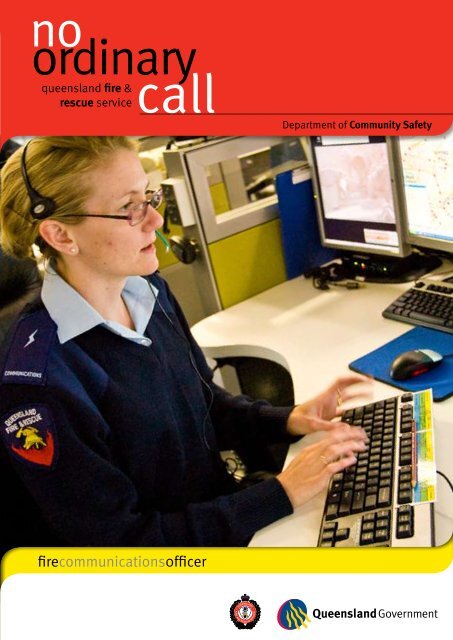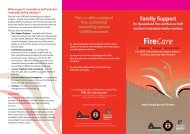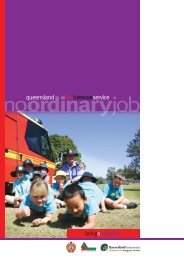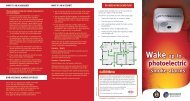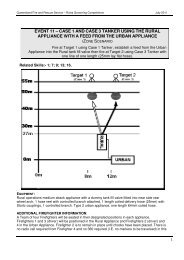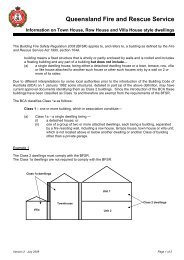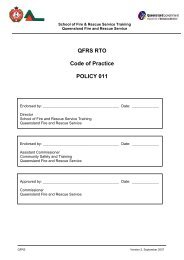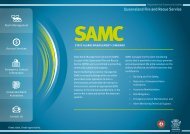Call - Queensland Fire and Rescue Service
Call - Queensland Fire and Rescue Service
Call - Queensland Fire and Rescue Service
- No tags were found...
You also want an ePaper? Increase the reach of your titles
YUMPU automatically turns print PDFs into web optimized ePapers that Google loves.
callDepartment of Community Safetyfirecommunications0fficer
firecommunications0fficer<strong>Queensl<strong>and</strong></strong> <strong>Fire</strong> <strong>and</strong> <strong>Rescue</strong> <strong>Service</strong> <strong>Fire</strong> Communications OfficerDepartment of CommunitySafety (DCS)The functions of the <strong>Queensl<strong>and</strong></strong> Department of CommunitySafety are unique. It is the only entity in Australia thatdelivers high quality correctional, ambulance, fire,emergency <strong>and</strong> disaster management services througha single agency. This collaborative approach across theservice <strong>and</strong> with key stakeholders delivers improved safetyoutcomes for the community.The operational divisions of the department are the<strong>Queensl<strong>and</strong></strong> <strong>Fire</strong> <strong>and</strong> <strong>Rescue</strong> <strong>Service</strong> (QFRS), <strong>Queensl<strong>and</strong></strong>Ambulance <strong>Service</strong> (QAS), Emergency Management<strong>Queensl<strong>and</strong></strong> (EMQ) <strong>and</strong> <strong>Queensl<strong>and</strong></strong> Corrective <strong>Service</strong>s (CS).The operational divisions are supported by Business Support<strong>Service</strong>s (BSS) <strong>and</strong> Strategic Policy <strong>and</strong> Executive <strong>Service</strong>s(SPES).The department has approximately 8,900 employees <strong>and</strong>is supported by more than over 10,000 volunteers across<strong>Queensl<strong>and</strong></strong>. The Department’s headquarters is locatedin Brisbane. Regional headquarters are also located atBeenleigh, Brisbane, Cairns, Maryborough, Caloundra,Rockhampton, Toowoomba <strong>and</strong> Townsville.Strategic purposeThe Department of Community Safety supports healthy, safe<strong>and</strong> secure communities through public safety, emergencymanagement <strong>and</strong> secure <strong>and</strong> appropriate correctionsservices.<strong>Queensl<strong>and</strong></strong> <strong>Fire</strong> <strong>and</strong> <strong>Rescue</strong> <strong>Service</strong> (QFRS)The QFRS is the primary provider of fire <strong>and</strong> rescue activitiesthroughout <strong>Queensl<strong>and</strong></strong>. The QFRS is responsible forcommunity safety, the protection of people, property<strong>and</strong> the environment from fire <strong>and</strong> chemical incidents;<strong>and</strong> in conjunction with other agencies for the rescue ofpeople trapped in vehicles, buildings <strong>and</strong> other emergencysituations. The QFRS plays an important community safetyrole <strong>and</strong> undertakes a comprehensive range of communityeducation <strong>and</strong> awareness programs. It is the role of the QFRSto provide a responsive service to the community, whichwill result in the minimisation of preventable fire fatalities<strong>and</strong> casualties <strong>and</strong> the minimisation of damage to property<strong>and</strong> the environment from fire <strong>and</strong> other hazards. <strong>Fire</strong>Communications Officers deliver a vital service to supportthese operations.We take the callEvery call for assistance responded to by the QFRS goesthrough one of seven <strong>Fire</strong> Communications Centres’throughout the State. <strong>Fire</strong> Communication Centres operate24/7, 365 days of the year; shifts are rostered on a rotatingbasis to cover this time.Each <strong>Fire</strong> Communications Centre is equipped withcomputer-aided dispatch systems, radio <strong>and</strong> telephonecommunications, computerised street directories <strong>and</strong> datalogging facilities.The position of QFRS <strong>Fire</strong> Communications Officerencompasses many skills, knowledge <strong>and</strong> task attributes,including:• the ability to respond professionally to emergencytriple zero (000) calls• the ability to type <strong>and</strong> input data at speed with ahigh degree of accuracy• the ability to actively listen <strong>and</strong> communicateassertively• the ability to forward plan <strong>and</strong> provide cleardirection• the ability to perform in a calm <strong>and</strong> professionalmanner• the ability to complete accurate <strong>and</strong> detailedreports• the ability to manage general administrative <strong>and</strong>other non-emergency calls for service.The first few minutes of any emergency situation may requireurgent intervention to save lives or property. A QFRS <strong>Fire</strong>Communications Officer is usually the first point of contactfor the community <strong>and</strong> as such, assists QFRS in its role ofminimising the number of preventable fire fatalities <strong>and</strong>casualties <strong>and</strong> minimizing damage to property <strong>and</strong> theenvironment from fire <strong>and</strong> hazards.QFRS <strong>Fire</strong> Communications Officer Recruitment Information Kit
firecommunications0fficerWhat do we offer?Careers <strong>and</strong> TrainingThe QFRS is committed to training <strong>and</strong> education asa long term investment aimed at maintaining a highlyskilled workforce.It is through quality training that a <strong>Fire</strong> CommunicationsOfficer develops the confidence, skills, knowledge <strong>and</strong>abilities to manage increasingly complex emergencysituations.QFRS <strong>Fire</strong> Communications Officers are requiredto successfully complete a Certificate III in <strong>Fire</strong>Communications Operations upon entry. This trainingwill include an induction within the Region, a period atthe School of <strong>Fire</strong> <strong>and</strong> <strong>Rescue</strong> <strong>Service</strong> Training, Lytton,Brisbane <strong>and</strong> on returning to region you will be placedon shift with an experienced <strong>Fire</strong> CommunicationsOfficer as your mentor. On completion of thiscompetency QFRS <strong>Fire</strong> Communications Officerswill enter the <strong>Fire</strong> Communications ProfessionalDevelopment Program (FCPDP) <strong>and</strong> be requiredto successfully complete training programs <strong>and</strong>qualifications relevant to their level.UniformsThe wearing of the QFRS uniform is required for theready identification of the QFRS <strong>and</strong> its staff. Theuniform ensures a common dress st<strong>and</strong>ard throughoutoperational areas of the QFRS. It also reflects, in thepublic image, the high individual st<strong>and</strong>ards of <strong>Fire</strong>Communications Officers <strong>and</strong> the critical communityservice they provide. Uniforms are issued at thesuccessful completion of the Certificate III in <strong>Fire</strong>Communications. The QFRS Uniform Code must beadhered to at all times.<strong>Fire</strong> Communications Officers also undertake trainingprograms, activities <strong>and</strong> assessments throughout theircareer to ensure their skills remain at an optimumlevel.Communications Officer Hours of Work<strong>Fire</strong> Communications Centres operate 24/7, 365 days ofthe year. <strong>Fire</strong> Communications Officers are required towork shifts on a rotating basis to cover this time. Theshifts are 10 - 14 hours in duration.RemunerationFor queries about current remuneration rates, pleasecontact QFRS Recruitment.SuperannuationThe QFRS contribute 12.75% to Q-Super; thesuperannuation scheme for <strong>Queensl<strong>and</strong></strong> PublicSector Employees. Permanent <strong>and</strong> TemporaryCommunications Officers are required to contributeto QSuper. Casual <strong>Fire</strong> Communications Officersmay make contributions on a voluntary basis. Foradditional information visit the website www.qsuper.qld.gov.auQFRS <strong>Fire</strong> Communications Officer Recruitment Information Kit
Recruitment <strong>and</strong> selection processThe recruitment <strong>and</strong> selection process for <strong>Fire</strong>Communications Officers has been designed torecruit individuals who are best suited to meet therequirements of the job.It is imperative that applicants underst<strong>and</strong> the totalrecruitment process <strong>and</strong> all stages of assessment in theselection process, before submitting an application.QFRS <strong>Fire</strong> Communications recruitment is a continuousprocess. This means that applications can be submitted<strong>and</strong> updated on an ongoing basis.The process has a number of stages <strong>and</strong> has beendesigned to enable QFRS to consider an applicant’sability to meet the requirements of the <strong>Fire</strong>Communication Officer’s job.QFRS will build up a file on applicants, which willinclude the application form, documents provided bythe applicant, <strong>and</strong> outcomes of assessments. Thisenables QFRS to select the applicants who are the mostsuitable overall for particular vacancies.All elements of the process contribute to determiningwhether an applicant is selected for appointment.The processThere are a number of stages in the process <strong>and</strong>applicants should familiarise themselves with thecomplete process before making application.Initially, applicants must submit an application form<strong>and</strong> supply certified documented evidence to showthey are an Australian resident <strong>and</strong> also documentedevidence of their education <strong>and</strong> work history, as wellas certified copies of other documentation required forapplication.If the application is accepted then applicants will beinvited to complete a work related assessment. This isavailable on a user pays system <strong>and</strong> there is a calendarof assessments available for applicants to refer to whenmaking their assessment bookings.Assessment outcomes will be sent to QFRS Recruitment<strong>and</strong> applicants will be notified by mail.If an applicant does not meet an acceptable level orhas not scored in a competitive range, they will benotified <strong>and</strong> given the opportunity to undertake a reassessment.There is a m<strong>and</strong>atory st<strong>and</strong>-down period before reassessmentcan be attempted of 3 months. Further reassessmentis available after a further 6 month period.Costs associated with any re-assessments are to becovered by the applicant.Those applicants who meet the required st<strong>and</strong>ardfor the work related assessmenmts are required tocomplete:• Medical assessment• Characteristics assessmentTo be considered for shortlisting for interview.As vacancies occur in QFRS, the Selection Committeewill meet to shortlist a number of suitable applicants foreach available position. It should be noted that all ofthe information collected, as part of an applicant’s file,will be considered in the shortlisting process.The Selection Committee will be a centrally convenedbody, which will be sponsored by the AssistantCommissioner - Sponsor Five Communications or theirdelegated officer.Membership of the Selection Committee includes:1 x Assistant Commissioner - Sponsor FiveCommunications or their delegated officer.1 x Manager Regional Communications or<strong>Fire</strong> Communications Supervisor1 x <strong>Fire</strong> Communications Officer (FCO1.4)1 x QFRS Recruitment representative/HumanResources representative.This committee will consider the information in thefiles of applicants who have nominated employmentlocations that match the vacancies for <strong>Fire</strong>Communication Officers.Shortlisted applicants will be invited to attend aninterview in the region where the vacancy exists. Aspeed typing validation will be scheduled in conjunctionwith the interview.This demonstrates those applicants who recordedbelow the highly desireable 45wpm have shownimprovement in obtaining a level of 45wpm or better; or,have maintained their recorded speed <strong>and</strong> accuracy.QFRS <strong>Fire</strong> Communications Officer Recruitment Information Kit
firecommunications0fficerMembership of the Interview panel includes:1 x Manager Regional Communications1 x <strong>Fire</strong> Communications Supervisor or <strong>Fire</strong>Communications Officer1 x DCS Officer (e.g. QFRS Station Officer, QASCommunications Supervisor etc.) or RegionalHuman Resources Officer.Interview panels will send a report to the SelectionCommittee on the outcome of each interview. At thisstage in the process, applicants who are selected forfurther consideration will be advised <strong>and</strong> will beasked to:<strong>Fire</strong> Communications OfficerRecruitment ProcessApplication1. Australian resident2. Education3. Work history4.• Undertake a Criminal History Check – these are tobe completed by the applicants <strong>and</strong> a copy of yourdriver’s licence will be sent to <strong>Queensl<strong>and</strong></strong> Policefor checking. Results of these checks will be sentto QFRS Recruitment who will advise the SelectionCommittee.• Undertake a Clinical Psychometric Assessment –applicants selected for further consideration willbe contacted by QFRS Recruitment to organise thisassessment within the local area where possible.3.1.AssessmentsWork related assessments2. MedicalCharacteristics AssessmentsApplicants not selected for further consideration willremain in the applicant pool for further processes.If final assessments/checks are completed to asatisfactory st<strong>and</strong>ard applicants are to be given an Offerof Employment. An applicant who accepts employmentas a <strong>Fire</strong> Communications Officer with the QFRS willthen undertake the recruitment training to complete theCertificate III in <strong>Fire</strong> Communications.Selection committee shortlist(based on whole file)2.1.InterviewSpeed typing validation3.Referee reportsSelection(based on whole file)1.Clinical Psychometric Assessment2. Criminal History CheckAppointmentQFRS <strong>Fire</strong> Communications Officer Recruitment Information Kit
Requirements for applicationBefore an applicant can be considered for a position,they will need to provide evidence of the followingapplication requirements:• Australian Citizenship, New Zeal<strong>and</strong> Citizenship orAustralian Resident Status.• Successful completion of Year 10 (or equivalent).• Minimum of two years full time equivalent generalwork experience.Australian residentThe QFRS only employs people entitled to acceptpermanent employment within Australia, that is,Australian citizens, New Zeal<strong>and</strong> citizens <strong>and</strong> those withpermanent residency status.Evidence of Australian citizenship, in the form of either acertified copy of a birth certificate or passport, must besubmitted on application.Evidence of New Zeal<strong>and</strong> citizenship, in the form ofa certified copy of a New Zeal<strong>and</strong> passport, must besubmitted on application.Applicants who have obtained Australian citizenship orpermanent resident status must provide certified copiesof appropriate documentation, including the date thestatus was awarded.Applicants who were not born in Australia <strong>and</strong> havenot applied for citizenship/ permanent residentstatus, should contact the Australian Department ofImmigration <strong>and</strong> Indigenous <strong>and</strong> Multicultural Affairs atwww.citizenship.gov.au or phone 131 880Education - successful completion of Year10 (or equivalent)QFRS is committed to training <strong>and</strong> education as along term investment aimed at maintaining a highlyskilled workforce. Applicants are therefore required todemonstrate that they have successfully completed aminimum of Year 10 level education or education whichcan be deemed as a Year 10 equivalent.For the purpose of a QFRS application for a <strong>Fire</strong>Communications Officer position:• successful completion of Year 10 implies a soundachievement obtained in a minimum of four Year 10subjects• year 10 equivalent implies completion of aCertificate II or higher (in any discipline).Applicants without these st<strong>and</strong>ard qualificationsmay need to have their qualifications assessed by<strong>Queensl<strong>and</strong></strong> Tertiary Admissions Centre (QTAC) or<strong>Queensl<strong>and</strong></strong> Studies Authority (QSA) prior to makingapplication. In some cases, applicants withoutst<strong>and</strong>ard qualifications can have their vocationalexperience assessed by QTAC to determine aneducational st<strong>and</strong>ard.For more information, contact QTAC Assessment ofQualifications <strong>Service</strong> at www.qtac.edu.au or QFRS atwww.fire.qld.gov.au.Work Historyminimum of two years full time equivalent general workhistoryA minimum of two years full time equivalent generalwork history is required for application. Other applicablework history above the minimum requirement will berecognised in the assessment process. Applicants willneed to provide evidence of their work history; this mayinclude certified copies of Statements of <strong>Service</strong> fromemployers. Part time work equivalent for two years is3640 hours.Other educational qualifications above the minimumrequirement will be recognised in the assessmentprocess. Applicants will need to supply certified copiesof all certificates / qualifications with their application.QFRS <strong>Fire</strong> Communications Officer Recruitment Information Kit
firecommunications0fficerAssessments <strong>and</strong> medicalst<strong>and</strong>ardsThe assessments for QFRS <strong>Fire</strong> CommunicationsRecruitment have been chosen to provide relevantinformation about an applicant.Work-related assessmentsThe work-related assessments have been formulatedto test for the key skills <strong>and</strong> abilities required to carryout the role of QFRS <strong>Fire</strong> Communications Officersuccessfully. The work-related assessments areconducted by a contracted provider. Informationon costs, assessment checks <strong>and</strong> schedules will beprovided once an application has been accepted.• typing (45 words/minute with a high degree ofaccuracy is highly desirable)• audio typing• listening comprehension• multi-tasking• spatial analysis• verbal communication skills• problem solving.Work-related assessment results will remain current for3 years (Typing must be updated annually <strong>and</strong> a typingtest will be required at interview). If an applicant doesnot meet an acceptable level or has not scored in acompetitive range, they will be notified <strong>and</strong> given theopportunity to undertake a re-assessment in the future.There is a m<strong>and</strong>atory st<strong>and</strong>-down period before reassessmentcan be attempted of 3 months. Furtherre-assessment is available after a further 6 monthperiod. Applicants can choose to re-sit the work-relatedassessments to improve their scores; this is at their owncost.Characteristics assessmentQFRS <strong>Fire</strong> Communications Officers play an importantrole within the emergency service environment. Theyrequire specific characteristics <strong>and</strong> traits, which areessential to ensure that they can carry out their activitieseffectively.A characteristics assessment profile has beendeveloped by identifying characteristics <strong>and</strong> traits whichsuccessful <strong>Fire</strong> Communications Officers within QFRSpossess. Applicants are required to undertake thecharacteristics assessment to determine their fit withthe <strong>Fire</strong> Communications characteristics profile.Medical assessmentThe role of QFRS <strong>Fire</strong> Communications Officer placesunique dem<strong>and</strong>s on individuals. The medical assessmentwill asses an applicant’s fitness for employmentagainst the following medical st<strong>and</strong>ards. The st<strong>and</strong>ardsare reflective of the critical job requirements, activities<strong>and</strong> environmental factors.The interviewThe interview is an important assessment tool inthe QFRS process of recruiting <strong>and</strong> selecting <strong>Fire</strong>Communications Officers. Applicants who have beenShortlisted as a result of their application <strong>and</strong> workrelatedassessments will be invited to attendan interview.What can you expect at interview?In the interview, the panel will take the opportunity todiscuss details of the vacancy <strong>and</strong> QFRS expectations ofnew employees.The interview will consist of questions based on theposition role. Responses to the questions will beassessed against the <strong>Fire</strong> Communications Officer roledescription (please see the separate Role Descriptiondocument)Preparing for interviewTo prepare for an interview, applicants should revise theduties <strong>and</strong> responsibilities <strong>and</strong> selection criteria <strong>and</strong> beprepared to answer any questions relating to either.Applicants will be asked questions which will allowthem to explain their skills, experience <strong>and</strong> abilities,<strong>and</strong> their claim to the position.Speed typing validationA five (5) minute typing validation will be conductedeither directly before or after the interview.This demonstrates those applicants who recordedbelow the highly desireable 45wpm have shownimprovement in obtaining a level of 45wpm or better; or,have maintained their recorded speed <strong>and</strong> accuracy.Referee reportsYou are required to provide contact details of two workreferees <strong>and</strong> two personal referees.Do not send written references.QFRS <strong>Fire</strong> Communications Officer Recruitment Information Kit
If you are claiming work history as a CommunicationsOfficer, you are required to include your currentmanager/supervisor as a referee.Members of your family or next of kin will not beaccepted as personal referees.Clinical psychometric assessmentAfter being offered a position with QFRS, but beforeappointment, applicants are required to undertake aclinical psychometric assessment. This assessmentwill be paid for by QFRS. If such an assessment raisesissues or concerns, QFRS may request that an applicantattend a psychiatrist or psychologist for furtherevaluation.Criminal history checkQFRS is committed to ensuring that its workforcecontains people with the highest st<strong>and</strong>ards of personalintegrity <strong>and</strong> as such may exclude people with certaincriminal histories from employment.A satisfactory criminal history check must be completedprior to an appointment being confirmed.QFRS medical st<strong>and</strong>ards -communicationsVisual acuityRationaleMost of the safety critical stimuli for <strong>Fire</strong>Communications Officer’s duties rely on adequatevisual skills. <strong>Fire</strong> Communications Officer duties includereading of visual display terminals <strong>and</strong> other writtenmaterial.St<strong>and</strong>ard• In the first instance, the Ishihara test will be usedas a screening test.• An individual identified as having any colourvision defects on the Ishihara test will be requiredto undertake a practical test of recognition ofessential colour codes on screens.The practical test will determine whether or notthe individual is fit for duty. (Individuals who haveno trouble in day-to-day activities discriminatingbetween reds, greens, oranges, <strong>and</strong> browns arelikely to pass the test).HearingRationaleClear comprehension of all callers, including females<strong>and</strong> children with higher pitched voices is a vitalrequirement of <strong>Fire</strong> Communications Officer. <strong>Fire</strong>Communications Officers require sufficient hearingabilities to safely <strong>and</strong> effectively perform their duties.These hearing abilities include hearing emergencycalls, <strong>and</strong> communicating with firefighters <strong>and</strong> otherpersonnel using radios.St<strong>and</strong>ardHearing thresholds must equal or be better than thefollowing thresholds in each ear at each frequency• 40 decibels at 0.5-4 kHz.<strong>Fire</strong> Communications Officers must also have adequatevoice discrimination.If a <strong>Fire</strong> Communications Officer does not meet theaudiometric threshold criteria, then they may be furtherassessed by formal voice discrimination testing, or apractical test.St<strong>and</strong>ard<strong>Fire</strong> Communications Officers must be able to achieve:• distant- 6/9 best eye or both eyes, aided orunaided• near - N5 best eye or both eyes, aided or unaided.Colour visionRationale<strong>Fire</strong> Communications Officers must be able todistinguish colours as the computer systems used todifferentiate unit status, availability <strong>and</strong> / or incidentpriority use colour combinations.QFRS <strong>Fire</strong> Communications Officer Recruitment Information Kit
firecommunications0fficerDiabetes mellitusRationaleIndividuals suffering from insulin dependent diabetesmellitus or who take sulphonylureas are at riskof hypoglycaemia, <strong>and</strong> the first manifestations ofhypoglycaemia may be disinhibition, <strong>and</strong> irrationalthought processes, before the more obvious signs <strong>and</strong>symptoms are apparent. Thus, diabetics need to becarefully evaluated before being permitted to work as a<strong>Fire</strong> Communications Officer. See Table 1 for a list of oralhypoglycaemic medication.Generic name Class Trade namesAcarboseGlucobayChlorpropamide Sulfonylurea DiabineseGlibenclamideSulfonylurea[lo n g a c t i n g]DaonilEugluconGlimelGliclazide Sulfonylurea DiamicronNidemGlimepiride Sulfonylurea Amaryl[lo n g a c t i n g]Glipizide Sulfonylurea MelizideMinidiabMetformin Biguanide DiabexGlucophageDiaforminPioglitazoneActosRosiglitazoneAv<strong>and</strong>iaToglitazoneTolbutamide Sulfonylurea RastinonSulfonylurea – risk of hypoglycaemiaList current as at 7 April 2006St<strong>and</strong>ardAll diabetics who are being treated with insulin orsulfonylureas are precluded from working as a <strong>Fire</strong>Communications Officer, unless they can demonstratethat their diabetes is adequately controlled, <strong>and</strong> thatthey are not liable to hypoglycaemic episodes. A reportfrom their treating endocrinologist would usually berequired to satisfy this requirement.Cardiovascular conditionsRationale<strong>Fire</strong> Communications Officers positions do not havethe same physical dem<strong>and</strong>s as operational firefightershowever it does have significant psychologicalstressors. Therefore, applicants should not be at anysignificant risk of fainting / collapsing, suffering alteredstates of consciousness or severe incapacitating chestpain than any other normal member of the community.St<strong>and</strong>ardIndividuals suffering from any of the followingconditions will be required to obtain a report froma cardiologist taking into account the critical jobdem<strong>and</strong>s:• Angina Pectoris• Suspected Angina Pectoris• Confirmed myocardial infarction• Coronary artery bypass, grafting or coronaryangioplasty• Vascular disorders• Uncontrolled hypertension• Valvular heart disease• Arrhythmia• Cardiomyopathy• Congenital heart disorder• Reoccurring fainting or blackouts.Please forward any such report to the QFRS MedicalAdvisor for review <strong>and</strong> determination of suitability forthe job.Epilepsy / seizuresRationaleIndividuals should not be at any significant risk offainting / collapsing or suffering altered states ofconsciousness due to epileptic episodes.St<strong>and</strong>ardIndividuals who have a demonstrated history of wellcontrolled epilepsy / seizures <strong>and</strong> have had no fitfor more than 12 months can be considered for a<strong>Fire</strong> Communications Officer position. However, anyapplicant with a history of seizures triggered by the useof monitors or where any doubt exists as to the potentialfor recurrent seizures will be required to obtain a reportfrom a neurologist taking into account the critical jobdem<strong>and</strong>s.QFRS <strong>Fire</strong> Communications Officer Recruitment Information Kit
Please forward any such report to the QFRS MedicalAdvisor for review <strong>and</strong> determination of suitability forthe job. A history of febrile convulsions limited to earlychildhood may be ignored.Psychiatric disordersRationaleIndividuals with psychiatric disorders will present anincreased risk to operational safety. A wide varietyof conditions can occur which may fluctuate in theirdegree of disability <strong>and</strong> transience. The precise effect ofalterations in mental state on decision-making processes<strong>and</strong> other tasks may also be unclear. Furthermore,administration of psycho tropic medication can affectalertness <strong>and</strong> coordination. Some antidepressantmedications may cause drowsiness <strong>and</strong> posturalhypotension. The potential for inter¬actions, especiallywith alcohol, should be noted.<strong>Fire</strong> Communications Officers activities includecomplicated psychomotor tasks which depend on fineco-ordination between the sensory <strong>and</strong> motor system.It is influenced by factors such as arousal, perception,learning, memory, attention, concentration, emotion,reflex speed, time estimation, auditory <strong>and</strong> visualfunctions, decision taking <strong>and</strong> personality. Complexfeedback systems interact to produce the appropriateco-ordinated behavioural response. Any condition thatinterferes with any of these factors can impair abilities tomake rational <strong>and</strong> appropriate decisions.St<strong>and</strong>ardAn individual is not fit for duty:• if they are taking psychoactive drugs, which willimpair performance on a long-term basis• if the individual has an acute psychosis, whetherschizophrenic, manic-depressive or otherdepressive psychosis. People who have affectivedisorders suffer from disturbances in attention,judgement, <strong>and</strong> motor activity that can seriously,even if temporarily, affect their fitness to work• if the examining doctor believes that an individual’sjudgement or psychomotor activity is currentlyaffected by present or past mental disorder• if the examining doctor believes that there is asignificant risk of a previous psychotic conditionrelapsing.A <strong>Fire</strong> Communications Officer who does not meet thest<strong>and</strong>ard may be reviewed by the QFRS Medical Advisor,who may determine that the individual is fit for duty:• if the relevant psychiatric opinion is supportive• if the communicator has a psychotic conditionwhich is so well controlled as to reduce the riskof an exacerbation to that of any member of thegeneral population• decisions on individual cases can only be madeafter all the facts are considered <strong>and</strong>, if in anydoubt, psychiatric consultation may be sought.MuscoskeletalRationaleThe nature of <strong>Fire</strong> Communications Officers dutiesrequires that they may be seated for long periodsof time.St<strong>and</strong>ardIndividuals reporting a history of back pain or aninjury that may be aggravated by prolonged sitting willneed to be carefully evaluated taking into account thejob dem<strong>and</strong>s, <strong>and</strong> may be required to obtain aspecialist report.GeneralWhile this st<strong>and</strong>ard should, in general, be adhered to,it is impossible to allow for all conditions. The st<strong>and</strong>arddoes not consider every possible disease, <strong>and</strong> in thecase of other medical conditions not detailed above,they must be judged on their merits, having regard tothe dem<strong>and</strong>s of the job.Any variation to the st<strong>and</strong>ards should be supportedby written medical opinion or specialist referral whereappropriate. The specialist must be aware that theperson is, or is being for a <strong>Fire</strong> Communications Officerposition <strong>and</strong> should state that specifically in his/heropinion. It is not sufficientsimply to state that an individual is “fit for work”.Supporting specialist reports/consultations are atthe applicant’s expense.If you require further advice about any conditionoutlined above, please contact the QFRS Recruitment..QFRS <strong>Fire</strong> Communications Officer Recruitment Information Kit


